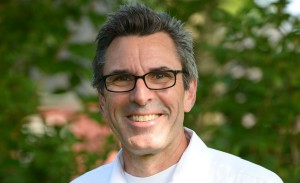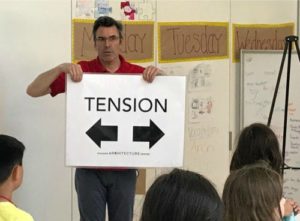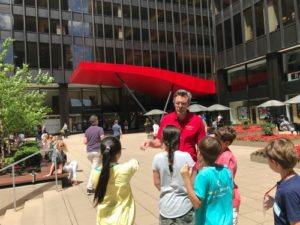By Brent Hoffmann, Class of 2005

“Basically, a dam is a barrier that contains water,” explains 26-year docent Kevin Griebenow, who jokingly refers to himself as “just a dam civil engineer.” He should know. He supervises 10 civil engineers at the Chicago office of the Federal Energy Emergency Commission (FERC). Their job is to review and approve the design, construction, operation and safety of hundreds of dams throughout the Midwest, including the Missouri Bagnell Dam that created the Lake of the Ozarks.
Kevin graduated from the University of Minnesota with a B.S. in civil engineering in 1981. But he wasn’t ready for a 9-to-5 job, so he joined the Peace Corps. “When I was told that I was going to north Yemen, my mom and I had to find it on the family globe,” he says. They found it at the southwest corner of the Arabian Peninsula. “Water is life in this hot, dry country,” explains Kevin, “and Yemen doesn’t enjoy the same oil resources as its middle-eastern neighbors.”
For two-and-a-half years, he built water tanks, installed pumps and laid pipelines for thirsty villages in that ancient land. “One of the first recorded dams is said to be the Great Dam of Ma’rib in Yemen,” he observes. “It dates from around the eighth-century BC, and is one of the engineering marvels of the ancient world. Some believe that the Queen of Sheba was from this area.”
I Bought a What?
He often had a companion during some of his Peace Corps days. “And it was my most successful bartering purchase,” he says. He was surveying a village for a water project, and a puppy-size animal with black and gray stripes and a bushy tail was offered to him for $50. A couple of village children asked him if he wanted to buy this ‘argi’,” recalls Kevin. Without an Arabic dictionary, he couldn’t look up the word ‘argj.’ By the end of the day, he still didn’t know what kind of animal it was, so he offered $5 and they accepted. Turns out an argj is a striped hyena. The realization that he’d bought a hyena slowly sank in. “I called her my ‘watch hyena’.” Unlike the spotted laughing hyena, the striped hyena makes a high-pitched, chattering sound when frightened. Unfortunately, I had to give her up when I returned to the U.S.”
The Move to Chicago
In 1985, Kevin, sans hyena, moved from Rochester, Minnesota, to Chicago to start his job at the Chicago district office of the U.S. Army Corps of Engineers. He modeled river hydraulics, and managed a beach revetment project to protect a section of Lake Michigan that was struggling with record-high water levels. Although he’d planned to return to his native Minnesota after a year or two, he remained in the Chicago area. From the Corps, Kevin moved to the Federal Emergency Management Agency as a project engineer with the National Flood Insurance Program. In 1989, he married Betsy from Park Ridge. A month after the wedding, he was sent to San Francisco on temporary assignment to assist with post-earthquake disaster relief. In 1990, he joined the Chicago Regional Office of the FERC as a civil engineer.
Kevin was a guest instructor at a student workshop (aka “kids camp”) at CAC this summer. The curriculum for the young teens focused on the basics of architectural engineering, including compression, tension, and demonstrations of load-bearing vs. steel-framed construction. He showed poster-size photos of one of his dam construction projects in Ohio with a cofferdam and hydroelectric powerhouse. He likened the cofferdam to a stadium-size bathtub — but in reverse because it keeps the river water out. He capped off instruction with a walk outside to show examples of cantilevers, arches with keystones and voussoirs, columns (some engaged) plus beams, trusses, vaults and domes. The father of two adult daughters, Kevin enjoys working with kids. “Their enthusiasm is infectious, and they’ll surprise you and teach you something.”
The CAC education department often calls on Kevin to answer engineering questions, make presentations on architectural styles and structures to docent and CAC-member groups, and develop and review aspects for the annual Engineering Festival. In August 2018, he was a panelist on A World of Innovation program of the Chicago Engineers’ Foundation of the Union League Club. It focused on Chicago’s 1893 World’s Fair. The panel discussed the inventions, engineering and logistics of the fair. “One of the more-surprising aspects of the fair was the use of giant steam-powered shovels and dredges that were described as ‘floating barns’ in the book The Devil in the White City,” he says. “Those shovels turned out to be Bucyrus-model steam shovels. And steam shovels would go on to be a major aid in completing the Panama Canal.” Kevin presented a similar talk on the planning, engineering and construction of the 1893 fair to CAC docents and volunteers in January 2019.

The Water Above
Kevin’s interest in water isn’t limited to dams. He also knows about the water above – the water held in the tanks of passive-tuned, mass-damping systems that minimize the sway of tall buildings in heavy winds. Examples are the 150 N. Riverside building on the south branch of the Chicago River and the new Vista Tower. In the top levels of 150 N. Riverside are 12 huge tanks that hold 160,000 gallons of water. Kevin explains: “The water sits in the tanks until the tower moves, but the water doesn’t initially move in the opposite direction. The three-foot-five-inch depth of water is ‘tuned’ so the frequency of the waves created as the building moves is out of step with the building’s frequency. Meaning that, when the generated wave travels to the other side of the tank, the building will be moving back in the opposite direction and counteracted by the wave hitting the tank wall.”
Learning & Access
He took the CAC docent enrichment trip to New York City in 2018. “My first time to the Big Apple,” he says. “The highlights of my trip included walking the High Line when the Vessel — the huge, basket-like public art structure — was under construction, crossing the Brooklyn Bridge, and standing in the Guggenheim Museum. Also, getting to know my fellow docents was a tremendous benefit of the trip. One of the joys of being a docent is the access it provides to learning about our built environment. Access is important, too, such as being invited to tour Aqua while it was being built, and getting a presentation and view of the foundation work for the Spire. As long as it’s fun and provide an educational environment, I’ll continue to be a dam civil docent.”




What a wonderful profile of a spectacular docent. Kevin adds to all of our knowledge with his engineering expertise. It’s a pleasure to work with him. Thanks, Brent, for a great story about a great docent.